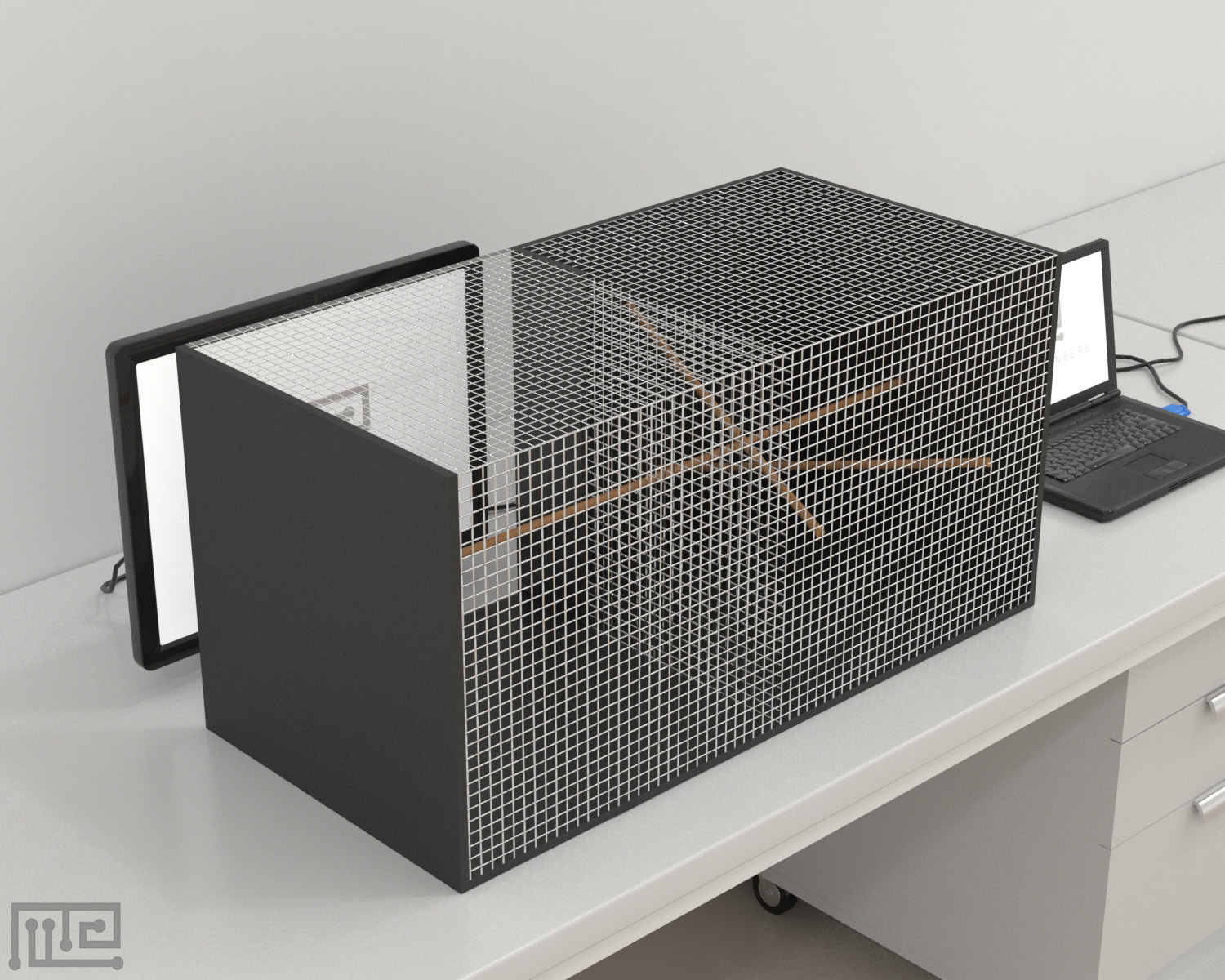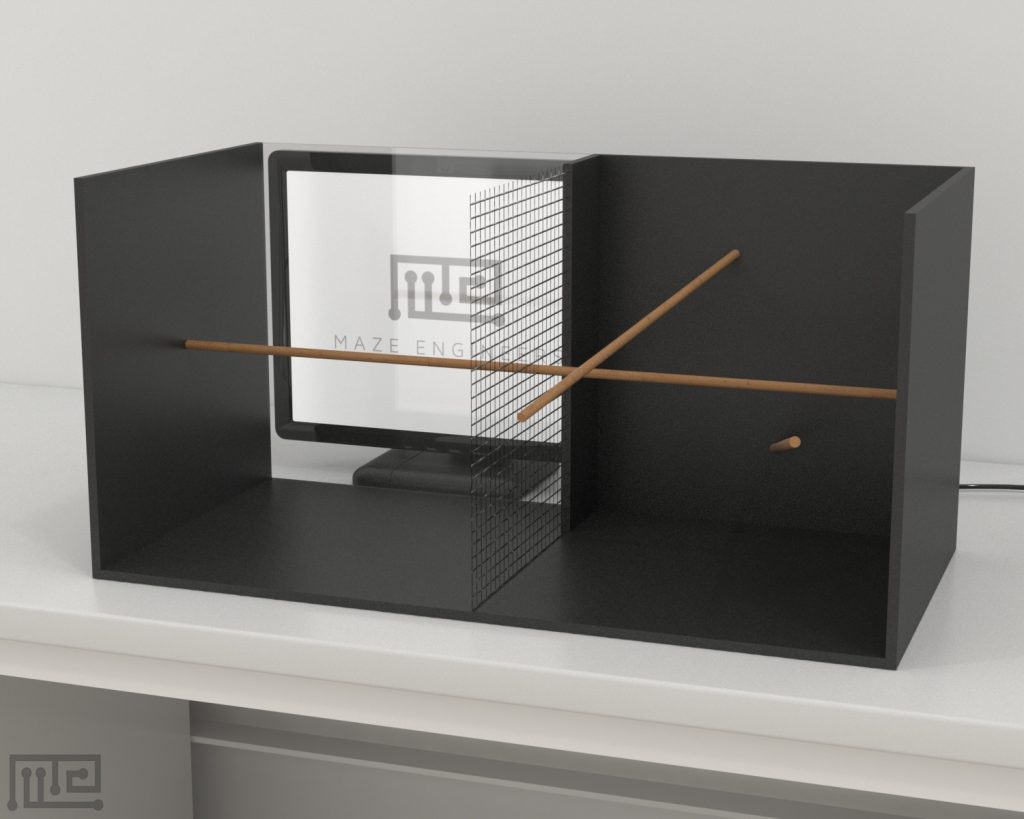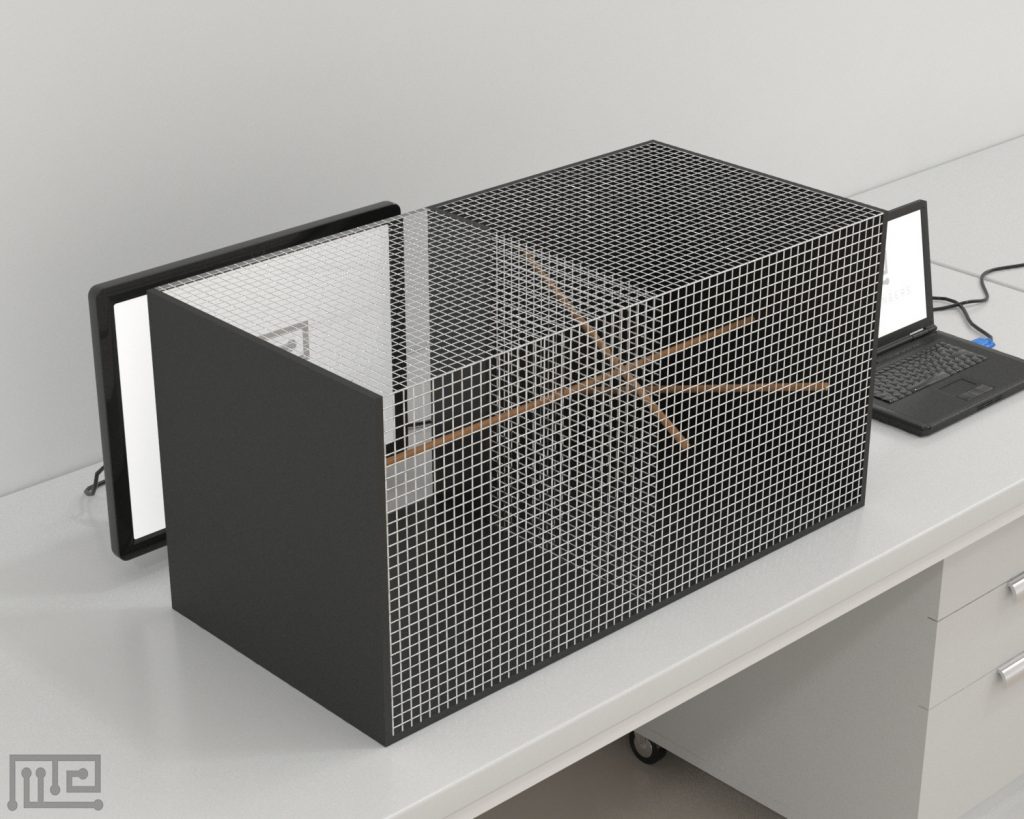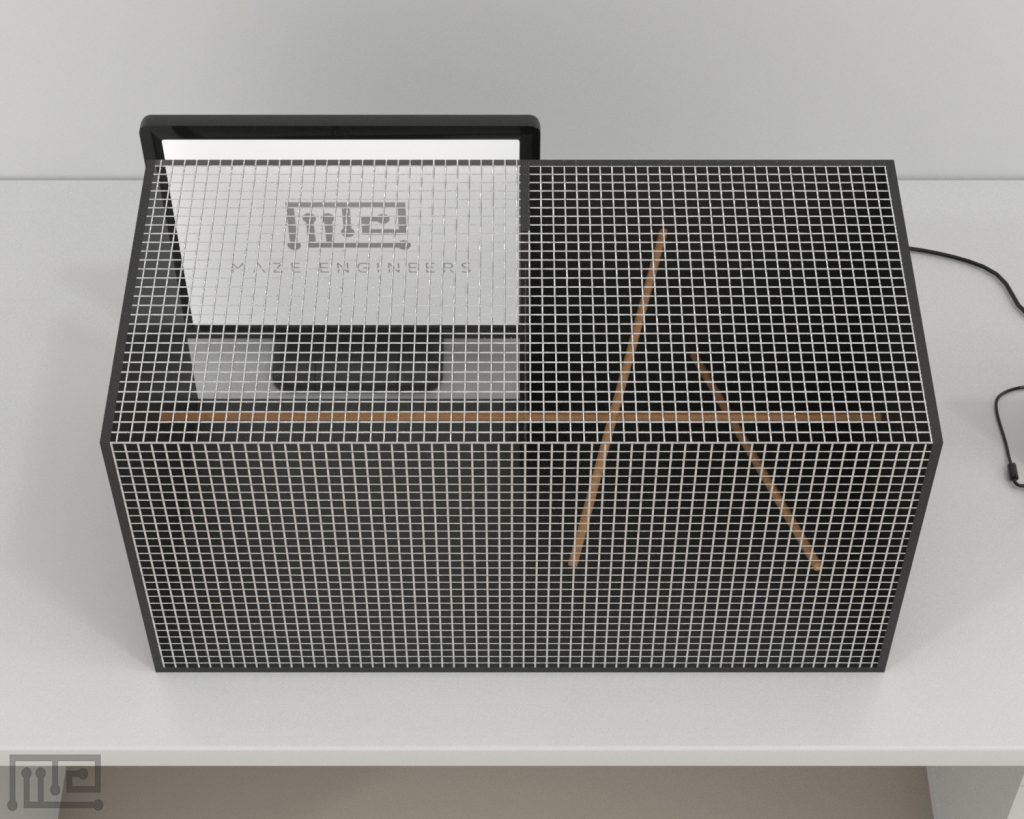Zebrafinch Two-Compartment Cage was used to assess behavioural responses to video playbacks by zebra finch males.
A two-compartment cage with a clear plexiglass front was used to prepare movies with zebra finch females in different social situations. The compartments of the cage were divided by wire mesh.
The stimulus bird was placed into one of the compartments. It was able to see, hear and react to the object in the adjacent cage compartment (another female, male or no animal).
Mazeengineers offers the Zebrafinch Two-Compartment Cage.
Price & Dimensions
Zebrafinch Two-Compartment Cage
$ 2990
+S&H- Length of cage: 82cm
- Width of cage: 40cm
- Height of cage: 40cm
Documentation
Introduction
The Zebra finch Two-Compartment Cage is used to study behavioral responses in zebra finches when presented with video playbacks.
Animals communicate through behavioral signals, where different types of signals elicit different behavioral responses (Seyfarth & Cheney, 2003). In birds, behavioral responses relating to courtship usually include courtship songs, beak wiping, tia calls, and tet calls (Galoch & Bischof, 2007). The Zebra finch Two-Compartment Cage takes advantage of this type of communicative signal-response relationship and can effectively be used to analyze courtship behaviors. It contains two compartments; one compartment contains a clear plexiglass front while the other compartment is made of opaque black walls. The clear plexiglass front allows the subject to view a Thin Film Transistor (TFT) screen that can be used to present video playbacks of conspecific or heterospecific stimulus birds in different social situations. Therefore, the type of signals given by the stimulus birds can be used to observe what type of behavioral responses they induce. Apart from visual signals, the Zebrafinch Two-Compartment Cage is also equipped with speakers behind the TFT screen to observe behavioral responses to the presence or absence of acoustic stimuli.
The Zebra finch Two-Compartment Cage can easily be modified according to different experimental needs. It contains a removable wire mesh partition that is used to separate the two compartments. The wire mesh is usually placed during the preparation of video clips of the stimulus birds. It is removed during testing to calculate the amount of time the subject spends in each compartment to observe preference behaviors.
Other apparatuses used to study zebra finch behaviors include the Zebrafinch Day Escape Maze, the Zebrafinch Testing Cage, the Zebrafinch Chamber Maze, the Magnetic Compass, and the Mate Choice Apparatus 2.
Apparatus and Equipment
The Zebra finch Two-Compartment Cage measures 82 cm in length, 42 cm in width, and 40 cm in height. One compartment contains a clear plexiglass front, and the other is made of opaque black walls. The two compartments are divided by a wire mesh partition. The compartment with the clear plexiglass front allows viewing an external TFT screen (15 in. NEC MultiSync 1525M), which has two speakers situated behind to present video clips. A short blind is present besides the TFT screen, which prevents it from seeing from the other compartment. The Zebra finch Two-Compartment Cage is also equipped with three perches, one perch runs along the whole length of the cage from the right to the left compartment, while the two other perches are present in the right compartment from the front to the back walls.
Training Protocol
Clean the cage after each trial to remove odor residues. Appropriately light the cage. A tracking and recording system such as the Noldus Ethovision XT can be used to assist with observations.
The following is a sample protocol to examine courtship behavioral responses to video playbacks in male zebra finches using the Zebrafinch Two-Compartment Cage.
Preparation of stimuli
Place a female stimulus bird in one compartment and place another female/male in the other compartment or keep it empty. Record the behavior of the stimulus bird for 30 minutes. Prepare five different types of stimulus movies for the playback experiment: a video clip showing an empty cage, a video clip of a zebra finch female with no other bird in the adjacent compartment, a video clip of a zebra finch female with another conspecific female in the adjacent compartment outside the view of the camera, a video clip of a zebra finch female with a courting male in the adjacent compartment, a video clip with a Bengalese finch female with an empty adjacent compartment. Use a video showing two other bird species (parrots and flamingos) as the control group.
Habituation
Remove the wire mesh partition of the cage. Place a male subject in the Zebrafinch Two Compartment Cage and allow it to explore and habituate with the environment for 30 minutes.
Zebra finch Two-Compartment Cage Task
Remove the wire mesh partition of the cage. Place the subject in the apparatus. Present an image of an empty cage on the TFT screen for one minute. After the presentation of the empty cage, play the series of 5-minute stimulus video clips on the TFT screen in random order. Present the empty cage image for 1 minute in between each video clip. Conduct two sessions in which one session contains sound in the video clips and one without sound.
Literature Review
Investigation of male zebra finch behavior when presented with video playbacks
Galoch and Bischof (2007) investigated behavioral responses in ten 120-day old male zebra finches (Taeniopygia guttata) when presented with video playbacks in the Zebrafinch Two Compartment Cage. The stimulus birds used in the study consisted of two zebra finch females, one zebra finch male, and one Bengalese finch female. The video clips of the female zebra finches in different social situations were also recorded on the Zebrafinch Two Compartment Cage. A female zebra finch was placed in one compartment of the cage while another female, male, or no animal was placed in the other compartment. A camera was placed in front of the compartment of the stimulus bird so that only that compartment could be seen, and the bird’s behavior was recorded for 30 minutes. A video clip showing parrots and flamingos filmed in a zoo was also shown as a control. In the video playback experiment, the partition that divided the two compartments of the cage was removed, and the time spent in each compartment by the male subject and behavioral responses such as courtship song performed, beak wiping behaviors, tia call, and tet call was recorded. Two sessions were performed in which one session consisted of the video clips with the sound on, and the other with the sound off. The results indicated that the subjects spent more time in the compartment with the TFT screen when a video clip of a conspecific female and a video clip of a Bengalese finch female was shown as compared to a video clip with an empty cage. It was observed that the subjects spent more time in the TFT compartment when the sound wasn’t on as compared to when the sound was on in the video clips that consisted of parrots and flamingos. In the observation of courtship song performed by the male subjects, results indicated that the courtship song performed was affected by the kind of video clip shown and the presence or absence of sound. Courtship song performed was significantly more for the video clips that showed conspecific females together with sound compared to those without sound or those of an empty cage or heterospecific birds. No significant differences were observed between all the video clips that didn’t have sound. Similarly, the zebra finch males also displayed significantly more beak wiping when the videos playback was of a conspecific female with sound compared to those without sound and those of an empty cage or heterospecific birds. Beak wiping frequency also significantly increased when the video playback showed a conspecific female, not seeing or reacting to another male. Observation of tia call reaction showed a similar pattern of responses as compared to courtship songs. The subjects performed more calls if the video clip contained sound with a conspecific female. The highest number of calls were recorded if the conspecific female was without any other birds present in the adjacent compartment. Observation of tet call reaction showed an influence of treatment but not of sound. The subjects performed significantly more calls if the video playback consisted of a zebra finch female housed beside a male as compared to playbacks of an empty cage.
Data Analysis
The following parameters can be observed using the Zebrafinch Two Compartment Cage:
- Time spent in the right compartment
- Time spent in the left compartment
- Number of courtship songs performed
- Number of times the subject wiped its beak
- Number of tia calls performed
- Number of tet calls performed
Strengths and Limitations
Strengths
The Zebra finch Two-Compartment Cage is used to observe behavioral responses in zebra finches when presented with different types of video playbacks. It can be used to prepare video clips of stimulus birds in different social situations and then be used to observe behavioral responses in the subjects to the type of social situation. The Zebra finch Two-Compartment Cage can be used to detect subtle differences in behaviors in both the stimulus birds and the subjects to determine the type of signal that elicited the behavioral response. It can be used to observe behavioral responses to both visual and acoustic stimuli. The Zebra finch Two-Compartment Cage contains a removable wire mesh partition that can be used to separate the two compartments of the cage. During testing, the wire mesh is removed to observe the compartment’s preference for the subject. It is also equipped with perches to make it more comfortable for the subjects, which also serve as resting spots.
Limitations
Factors such as age, gender, and strain of the subjects may affect task performance. It is essential to wash the maze thoroughly in between trials to avoid the interference of odor cues from previous trials. The exploratory drive of subjects may affect task performance. Unintentional stimuli may affect the subject’s task performance.
Summary
- The Zebra finch Two-Compartment Cage is used to study behavioral responses in zebra finches when presented with video playbacks
- It consists of two compartments that are separated by a removable wire mesh partition.
- One compartment contains a clear plexiglass front that allows viewing of an external screen for the presentation of video clips while the other compartment is made of opaque black walls.
- The Zebra finch Two-Compartment Cage allows observation of behavioral responses to both visual and acoustic stimuli.
References
- Galoch, Z., & Bischof, H. J. (2007). Behavioural responses to video playbacks by zebra finch males. Behavioural processes, 74(1), 21–26. https://doi.org/10.1016/j.beproc.2006.09.002
- Seyfarth, R. M., & Cheney, D. L. (2003). Signalers and receivers in animal communication. Annual review of psychology, 54, 145–173. https://doi.org/10.1146/annurev.psych.54.101601.145121





